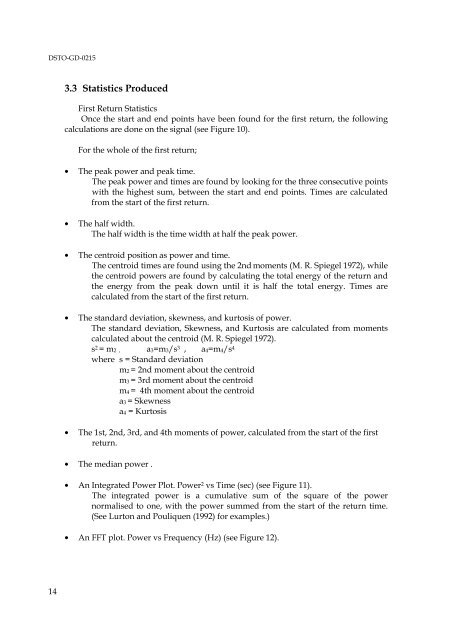The ABCS Program for the Analysis of Echo Sounder Returns for ...
The ABCS Program for the Analysis of Echo Sounder Returns for ...
The ABCS Program for the Analysis of Echo Sounder Returns for ...
Create successful ePaper yourself
Turn your PDF publications into a flip-book with our unique Google optimized e-Paper software.
DSTO-GD-02153.3 Statistics ProducedFirst Return StatisticsOnce <strong>the</strong> start and end points have been found <strong>for</strong> <strong>the</strong> first return, <strong>the</strong> followingcalculations are done on <strong>the</strong> signal (see Figure 10).For <strong>the</strong> whole <strong>of</strong> <strong>the</strong> first return;• <strong>The</strong> peak power and peak time.<strong>The</strong> peak power and times are found by looking <strong>for</strong> <strong>the</strong> three consecutive pointswith <strong>the</strong> highest sum, between <strong>the</strong> start and end points. Times are calculatedfrom <strong>the</strong> start <strong>of</strong> <strong>the</strong> first return.• <strong>The</strong> half width.<strong>The</strong> half width is <strong>the</strong> time width at half <strong>the</strong> peak power.• <strong>The</strong> centroid position as power and time.<strong>The</strong> centroid times are found using <strong>the</strong> 2nd moments (M. R. Spiegel 1972), while<strong>the</strong> centroid powers are found by calculating <strong>the</strong> total energy <strong>of</strong> <strong>the</strong> return and<strong>the</strong> energy from <strong>the</strong> peak down until it is half <strong>the</strong> total energy. Times arecalculated from <strong>the</strong> start <strong>of</strong> <strong>the</strong> first return.• <strong>The</strong> standard deviation, skewness, and kurtosis <strong>of</strong> power.<strong>The</strong> standard deviation, Skewness, and Kurtosis are calculated from momentscalculated about <strong>the</strong> centroid (M. R. Spiegel 1972).s 2 = m2 , a3=m3/s 3 , a4=m4/s 4where s = Standard deviationm2 = 2nd moment about <strong>the</strong> centroidm3 = 3rd moment about <strong>the</strong> centroidm4 = 4th moment about <strong>the</strong> centroida3 = Skewnessa4 = Kurtosis• <strong>The</strong> 1st, 2nd, 3rd, and 4th moments <strong>of</strong> power, calculated from <strong>the</strong> start <strong>of</strong> <strong>the</strong> firstreturn.• <strong>The</strong> median power .• An Integrated Power Plot. Power 2 vs Time (sec) (see Figure 11).<strong>The</strong> integrated power is a cumulative sum <strong>of</strong> <strong>the</strong> square <strong>of</strong> <strong>the</strong> powernormalised to one, with <strong>the</strong> power summed from <strong>the</strong> start <strong>of</strong> <strong>the</strong> return time.(See Lurton and Pouliquen (1992) <strong>for</strong> examples.)• An FFT plot. Power vs Frequency (Hz) (see Figure 12).14
















